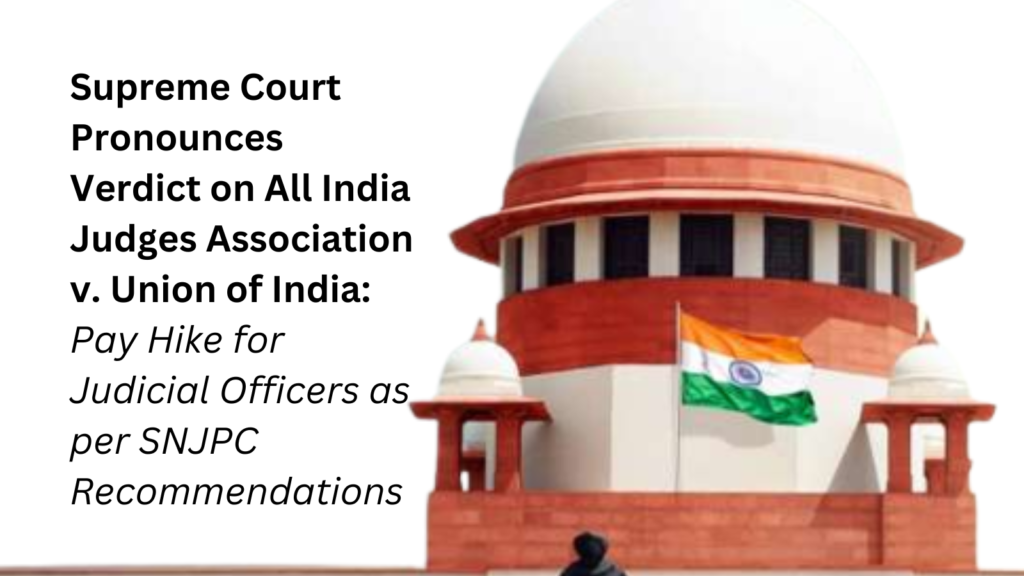Supreme Court Pronounces Verdict on All India Judges Association v. Union of India: Pay Hike for Judicial Officers as per SNJPC Recommendations.
Today, the Supreme Court delivered its judgment in the case of All India Judges Association v. Union of India, which centered around the issue of salary increments for judicial officers based on the suggestions put forth by the Second National Judicial Pay Commission (SNJPC). Authored by Justice PS Narasimha, the court carefully examined and approved various SNJPC recommendations pertaining to the remuneration, pension, gratuity, and retirement age of judicial officers. Furthermore, the judgment also included a specified timeline for both the Center and the States to ensure the payment of pension to retired judicial officers in accordance with the enhanced pay scale.
Emphasizing the significance of these principles in shaping its decision on the recommendations, the court shed light on key judicial tenets. This article provides an in-depth analysis of the five principles outlined by the Supreme Court in the present judgment, which were derived from a compilation of previous judgments.
Principle I: Ensuring Consistency in Designations and Service Conditions
The judgment introduces the first principle, which stresses the importance of maintaining uniformity in the designations and service conditions of judicial officers. According to this principle, a unified judiciary necessitates that the service conditions for judges in one state are comparable to those of their counterparts in other states. The judgment underscores the significance of providing appropriate incentives and promotion opportunities to judges of exceptional competence and ability, as this is crucial for upholding the judiciary’s efficient functioning and preserving its high standards.
The Court observed that the First National Judicial Pay Commission proposed a standardized nomenclature consisting of Civil Judge (Junior Division), Civil Judge (Senior Division), and District Judge. However, it was noted that this uniform nomenclature is not consistently implemented across the country. For instance, in the State of Kerala, the judges are referred to as Munsiff and Subordinate Judges, while variations exist in the North-East region as well.
Principle II: Maintaining Separation of Powers and Distinction from the Political Executive
The second principle outlined in the judgment concerns the concept of separation of powers, emphasizing the need to treat Judiciary officers separately and independently from the staff working in the legislative and executive branches. The judgment underscores that judges are not mere employees of the State but hold public office, wielding sovereign judicial power. In this sense, they can only be compared to members of the legislature and ministers in the executive.
Consequently, the judgment highlights that judicial officers cannot be equated with the staff of the legislative and executive wings, and thus, there should be no objection to the judicial officers receiving salaries that are not on par with the executive staff. Moreover, this distinction holds significance as judicial independence from the executive and legislature necessitates that the judiciary has a say in matters pertaining to its finances.
While addressing this principle, the court refuted the argument put forth by the States and the Union that implementing the recommendations of the SNJPC would impose a significant financial burden. The court highlighted that Judicial Officers had been functioning without a pay revision for approximately 15 years and that the issue of limited financial resources had been discussed on multiple occasions during the proceedings. In response, the court firmly asserted that Judicial Officers cannot be left without a pay revision for extended periods based on purported financial constraints.
Principle III: Inclusion of District Judiciary’s Independence in the Basic Structure
The third principle elucidated in the judgment asserts that the independence of the district judiciary is an integral component of the Constitution’s basic structure. While acknowledging that the Supreme Court has consistently recognized the independence of the judiciary as a fundamental aspect of the basic structure, the present judgment emphasizes that these pronouncements have primarily pertained to the High Court and the Supreme Court, rather than the District Judiciary. However, recognizing the vital role played by the District Judiciary in upholding the rule of law, the court affirms that the independence of the District Judiciary should also be deemed as an equally fundamental element of the Constitution’s basic structure.

Principle IV: Judicial Independence and Access to Justice for Effective Implementation of Part III of the Constitution
The fourth principle encapsulated in the present judgment highlights the critical role of judicial independence and access to justice in ensuring the implementation of an individual’s fundamental rights enshrined in Part III of the Constitution. The court asserts that any interpretation of Part III must recognize the importance of an independent District Judiciary in facilitating the effective and expeditious resolution of cases. The court emphasizes that the right to a fair trial and access to justice, as envisioned by the judiciary, extends beyond mere physical access to a court.
It encompasses essential prerequisites such as adequate infrastructure and the presence of unbiased, impartial, and independent judges. The court reiterates that, considering the District Judiciary serves as the primary point of access to justice for most litigants in the country, the independence of the district judiciary assumes even greater significance.
By underscoring the connection between judicial independence, access to justice, and the realization of fundamental rights, the court underscores the need for an impartial and efficient District Judiciary. It emphasizes that an independent judiciary is vital for safeguarding the rights of individuals and ensuring the effective functioning of the justice system. Recognizing that access to justice is not limited to physical proximity to a court, the court emphasizes the importance of providing a conducive environment that upholds the principles of fairness, impartiality, and independence.
Furthermore, the court emphasizes that access to justice is intricately linked to the availability of necessary infrastructure and resources. It emphasizes the obligation to provide litigants with an accessible and reliable judicial system, with the District Judiciary playing a crucial role in fulfilling this obligation. The court highlights that the independence of the District Judiciary is of paramount importance, as it directly impacts the accessibility and fairness of the justice system.
In conclusion, the fourth principle affirms that judicial independence, coupled with access to justice, is indispensable for the effective implementation of Part III of the Constitution, ensuring the protection of fundamental rights and the preservation of the rule of law. The District Judiciary’s independence and its ability to provide an impartial and efficient judicial process are critical components in upholding the principles of justice and enabling citizens to exercise their rights effectively.
Principle V: Ensuring Equivalence of Judicial Functions between District Judiciary and Higher Judiciary
The fifth principle elucidated in the judgment emphasizes the necessity of integration in terms of pay, pension, and other service conditions across the District Judiciary, High Courts, and the Supreme Court for achieving true unity within the judicial system. The judgment asserts that to maintain a hierarchical structure within the unified judicial system, it is only fair that the pay of a District Judge should not exceed that of a High Court judge since the latter holds a higher position in the judicial hierarchy. However, the judgment further clarifies that any salary increment granted to judges of the High Court should be proportionally reflected in the salaries of judges in the District Judiciary.
In order to establish a truly unified judicial system, it is crucial to ensure consistency and parity in the remuneration and service conditions across different levels of the judiciary. While recognizing the hierarchical nature of the judiciary, the judgment emphasizes that the District Judiciary and the Higher Judiciary should be treated equitably in terms of compensation. This principle aims to prevent any significant disparity in salaries between judges at different levels and promote a sense of cohesion and unity within the judicial system.
The judgment underscores that maintaining a proper balance in pay structures is essential to preserve the integrity and effectiveness of the judiciary as a whole. It acknowledges the hierarchical positioning of judges in the unified judicial system, wherein judges of the High Court hold a higher rank compared to District Judges. Consequently, it is deemed appropriate that the pay scale of a District Judge should not surpass that of a High Court judge. However, the judgment also emphasizes the importance of proportionality and equitable adjustments, stating that any salary increment provided to High Court judges should be extended in a similar proportion to judges in the District Judiciary.
By promoting the equivalence of judicial functions and equitable treatment in terms of compensation, the fifth principle seeks to ensure harmony and fairness within the judicial system. It recognizes the interdependence of different levels of the judiciary and emphasizes the need for a unified and cohesive approach in addressing the remuneration and service conditions of judges.
In summary, the fifth principle underscores the significance of integrating pay, pension, and service conditions across the District Judiciary, High Courts, and the Supreme Court to establish a unified judicial system. It advocates for maintaining parity in salaries between judges of different ranks while also emphasizing the importance of proportionality in salary increments. This principle aims to foster cohesion, fairness, and effectiveness within the judiciary, ultimately upholding the integrity and efficiency of the entire judicial system.
Also Read: https://legalreferencer.in/supreme-court-verdict-on-the-uddhav-thackeray/

